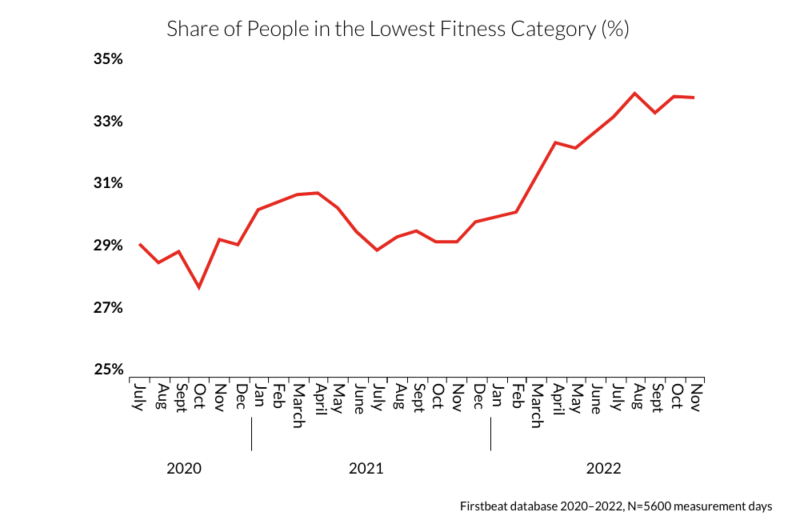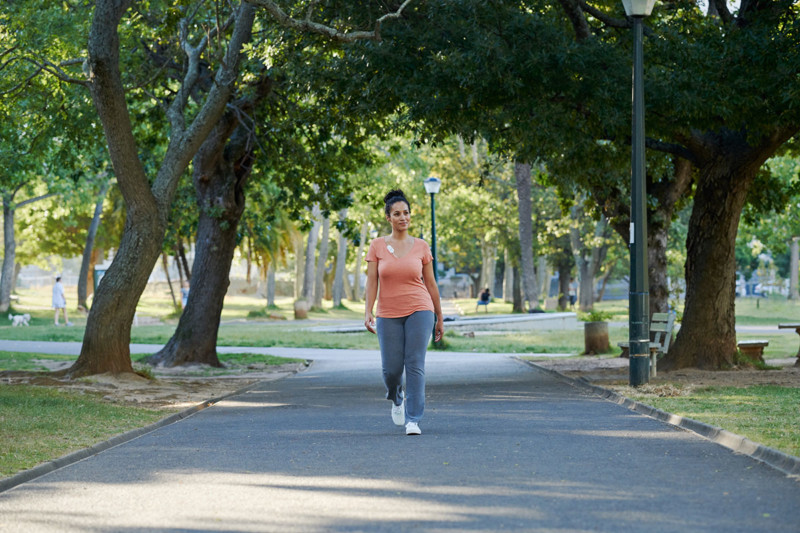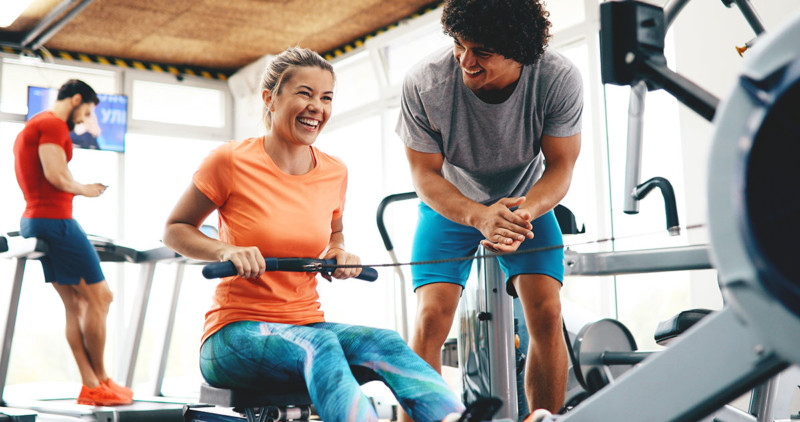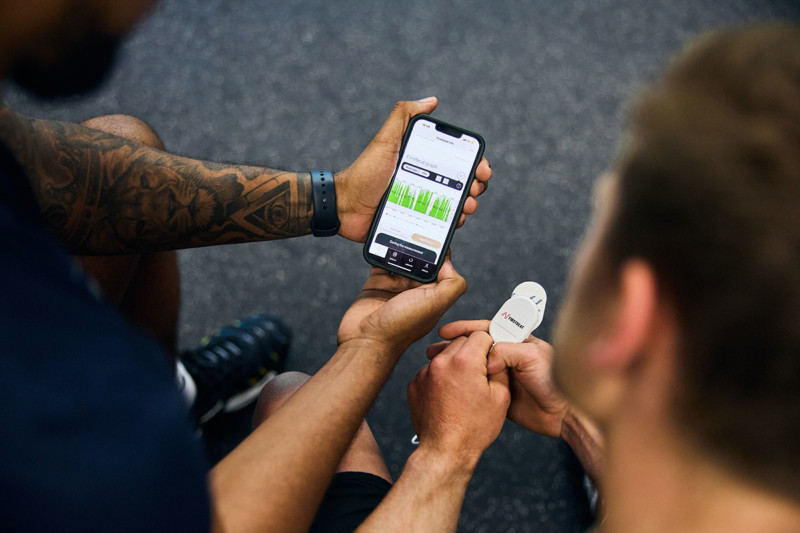
Have you been dreaming about being fitter and more able to fully enjoy life, with the energy to do the things that you enjoy after work? Maybe start a new hobby or rekindle a favorite old one?
It might be predictable but getting fit is still a timely and very sensible New Year’s resolution. We noticed a worrisome trend in the Firstbeat wellness database during 2022, with an increasing share of people in the poor fitness category (Figure 1).
The Effects of The Pandemic Linger On
With the pandemic gradually passing behind us, we have returned to the office, and as a result, have seen a boost in the amount of natural physical activity during the workday when compared to remote work, and we have also been able to start our hobbies again. However, the effects of the pandemic seem to linger on, and the higher number of people with poor fitness is probably at least partially explained by the extensive movement restrictions during the pandemic.
Fitness does not drop right away when we stop exercising, and so we are noticing the fitness drop with a slight delay. When the restrictions started, our database showed an immediate drop in the amount of daily physical activity and the number of steps, and it looks like this is reflected as reduced fitness later on.
Even with restrictions lifted in most places, the return to normal exercise and hobbies seems to have been slower. In addition to Firstbeat’s physiological data, other numbers and statistics suggest the same. For example, some companies have noticed that fewer people are still attending scheduled company exercise sessions than before the pandemic. The restrictions caused people to skip more intensive exercise, such as ball games and group exercise, and if they continued to do this, replacing it with easier physical activities, it might not be enough to maintain or improve fitness, especially with those who are already in good fitness.

Figure 1. The share of people in the lowest fitness category started to increase in 2022. In December 2020, the share of those in poor fitness was 29%, whereas in December 2022, the share was 34%. The result is based on a 30-minute fitness level walk conducted as part of Firstbeat Life measurements in 2020 – 2022. (N =5600)
Regular Exercise Has Many Health Benefits
Regular physical activity promotes and protects both physical and mental health. Increasing the amount of physical activity and improving one’s fitness is a smart investment in a healthier future because according to the WHO, physical inactivity ranks as the fourth largest risk factor of early mortality. Excessive sitting and inadequate movement also cause shorter-term problems and illnesses, for example related to metabolism or the musculoskeletal system.
According to a WHO report, 81% of adolescents and 28% of adults do not currently meet the general physical activity recommendations. This not only has a negative impact on the individual’s life, but it is also a major burden on the healthcare system and society on a larger level, via direct and indirect costs caused by inactivity-related illnesses.
Another study conducted in 174 nations suggests that the world is facing a troubling increase in physical inactivity that could result in >500 million new preventable cases of chronic disease by 2030 and a $300 billion burden on the society. Regular physical activity is a key protective factor in the prevention and management of non-communicable diseases. People who meet the recommendations have a 20–30% smaller risk of premature death. About 7 – 8% of all cardiovascular diseases, depression, and dementia, and about 5% of type 2 diabetes cases could be prevented if people were more physically active.
Furthermore, physical activity promotes better recovery. Firstbeat Life measurements have demonstrated that even one exercise session can effectively activate the parasympathetic nervous system after the exercise, which means better recovery and the body returning to a resting state. Measurements have also shown that the recovery process starts faster, and the amount and quality of recovery gets better when fitness improves. Many people have learned from experience that it’s easier to have the energy to do various chores when your fitness level is good. The best news is that it’s never too late to start gaining the benefits of exercise, regardless of how old you are now.
Firstbeat well-being data reveals the impact of remote working on everyday life →
Improve Your Fitness and Save Energy!
The beginning of a new year is a rather stereotypical, but also a fitting time to make some changes or updates to your lifestyle, and “getting fit” is one of the most popular New Year’s resolutions. This January, the global energy crisis is also forcing many of us to find ways to save electricity in our daily lives. Perhaps we could see this as an opportunity – in addition to the health reasons to exercise, why not motivate ourselves to get active with a cost-savings angle?
The following tips can help boost your personal fitness and save energy at the same time:
- Leave your car at home and walk or cycle to work two or three days per week, if possible. Or put on your backpack and walk to the nearest supermarket to do your daily shopping, instead of jumping in the car. You will improve your endurance – but also save on gas and do a kind act for the environment.
- If you live in a snowy area, embrace snow shovelling as a great form of exercise for your upper body muscles as well as the heart – just don’t overdo it. Or go sledding with your kids and get your heart rate up when you climb up the hill again and again.
- If snow is scarce where you live, do some manual work in your garden to get your muscles moving and blood flowing.
- Towards the spring and summer, utilize nature’s bounty and save on grocery expenses – try picking berries or mushrooms, or go fishing. Or for those in the northern climates, how about ice fishing this winter; drilling the fishing hole in the ice is a workout in itself! Being outdoors and in the forest has also been found to reduce stress levels and boost your mood.
The Foundation of a Good Exercise Plan
Getting fit makes sense on many levels but keep these key exercise principles in mind when you make your plan to improve your fitness: exercise regularly, with gradual progression and periodization (easier vs. harder) and get sufficient rest. In other words, it´s important to be physically active several timer per week several times per week (almost daily); otherwise, it’s hard to see improvements.
Furthermore, because the body quickly adjusts to certain kinds of training, you should gradually increase the volume or intensity, for example, every few weeks or months, to continue to see improvements. To make optimal fitness gains, remember to alternate between easy, moderate, and more intensive workouts and training periods.
And finally – be sure to get sufficient rest because fitness actually improves when you are resting. If your recovery is insufficient, your fitness can drop regardless of how hard you are working out.
Have a happy and active 2023!
Source:
Global status report on physical activity 2022. WHO featured publication, 18 October 2022.
This is a translation from Satu Tuominen’s original blog in Finnish.
Balancing stress and recovery is on everyone’s agenda. Firstbeat Life offers you a unique capability to succeed in the growing market for proactive health and well-being services. Integrate Firstbeat Life into your services to help your business grow and thrive.
You might also be interested in

How to Keep Your Stress Levels in Check When Hybrid Working
The COVID-19 pandemic forced millions of people into remote work and we have learned that it’s possible to do a lot of jobs and work tasks remotely. Hybrid working, which…

New Study Reveals that the Firstbeat Fitness Level Walk is a Valid Tool for Cardiorespiratory Fitness Evaluation in Clinical Populations
Cardiorespiratory fitness (measured as VO2max) is an expression of the body’s ability to deliver and utilize oxygen for energy during physical exercise. It reflects the interplay between respiratory, cardiovascular, and…

Are You Exercising the Right Way to Improve Your Health and Fitness?
The strong link between physical fitness and health is undeniable. After all, a 10% improvement in fitness can add 10 more ‘quality years’ to your life*. But did you know that…




